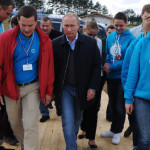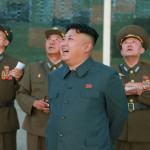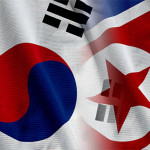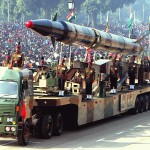- DETERRENCE: Don’t Mess with Nuclear Russia
- DPRK: U.S. Officials Visited N. Korea before Joint Exercise: Report
- GOVERNANCE AND CIVIL SOCIETY: Joint Survey Reflects Shifting Perspectives on Unification
- CLIMATE CHANGE ADAPTATION: Risky Business: the Economic Risks of Climate Change in the United States
- ENERGY SECURITY: Indian Nuclear Must Grow 15 Times for Clean Future
 DETERRENCE: Don’t Mess with Nuclear Russia, Putin says, Alexei Anishchuk, Reuters (August 29, 2014)
DETERRENCE: Don’t Mess with Nuclear Russia, Putin says, Alexei Anishchuk, Reuters (August 29, 2014)
President Putin: “Russia’s partners…should understand it’s best not to mess with us…Thank God, I think no one is thinking of unleashing a large-scale conflict with Russia. I want to remind you that Russia is one of the leading nuclear powers.” Is this swaggering braggadocio unlinked to a specific threat? Or is it linked implicitly to the Ukrainian conflict?
- If Putin goes nuclear, Tom Nichols, The War Room blog, September 1, 2014
- Russia to get new intercontinental ballistic missiles path control system & expand Nuclear forces Aug, The Moscow Times, August 19-2014
- Fifth Borei Class, Fourth Yasen Class Submarines to Form Backbone of Russian Navy, Vasily Batanov, RIA Novosti, July 27, 2014
 DPRK: U.S. Officials Visited N. Korea before Joint Exercise: Report. GlobalPost (28 August 2014).
DPRK: U.S. Officials Visited N. Korea before Joint Exercise: Report. GlobalPost (28 August 2014).
North Korea is significantly increasing its external contacts which indicate DPRK internal changes. However, it is unclear exactly what has changed internal to the DPRK or their ultimate strategic objective. Perhaps DPRK wants to move away from China, perhaps it wishes to move toward the US. Both courses of action are consistent with internal strengthening or internal fractures. DPRK sometimes created situations which were doomed to failure in order to conduct internal purges. An official US delegation visited Pyongyang, North Korea’s Foreign Minister will visit the UN, another North Korean diplomat will visit Europe and foreign wrestlers returned to the North Korean stage after two decades of absence. Increased cultural exchanges are consistent with past US-North Korea joint statements on bettering relationships.
- Americans detained in North Korea call for US help. Times of India. (1 September 2014)
- Veteran NK diplomat likely to visit Europe this week. Yonhap News Agency. (2 September 2014)
- N. Korea Foreign Minister to visit U.S. for first time in 15 years. KBS World Radio. (30 August 2014)
 GOVERNANCE AND CIVIL SOCIETY: Joint Survey reflects Shifting Perspectives on Unification, Koo Jun Hoe, Daily NK (27 August 2014)
GOVERNANCE AND CIVIL SOCIETY: Joint Survey reflects Shifting Perspectives on Unification, Koo Jun Hoe, Daily NK (27 August 2014)
A poll of ROK students and educators shows a majority supporting unification with the DPRK, citing instability and the threat of war as the main reasons. The same poll was seen differently by some conservative media outlets, pointing out instead that 20 percent of those surveyed do not support unification. Negative feelings in DPRK citizens towards the ROK seem to be increasing, while others pursue a new type of “sports diplomacy” with the DPRK.
- Poll: One-fifth of students oppose unification idea, Kim Hee-Jin, Joonang Ilbo (28 August 2014)
- North Koreans’ opinion of South deteriorating: survey, Jeong Hunny, Korea Herald (28 August 2014)
- Pro wrestlers make unlikely peace trip to North Korea, Anna Fifield, Washington Post (30 August 2014)
 CLIMATE CHANGE ADAPTATION: Risky Business: the Economic Risks of Climate Change in the United States, A Climate Risk Assessment for the United States, Kate Gordon et al., Risky Business, United States (June 2014)
CLIMATE CHANGE ADAPTATION: Risky Business: the Economic Risks of Climate Change in the United States, A Climate Risk Assessment for the United States, Kate Gordon et al., Risky Business, United States (June 2014)
The American economy faces multiple and significant risks from climate change. The signature effects of human-induced climate change – rising seas, increased damage from storm surge, more frequent bouts of extreme heat – all have specific, measurable impacts on U.S. current assets and ongoing economic activity. However, the U.S. can still avoid most of the worst impacts and significantly reduce the odds of costly climate outcomes by acting now.
- What is the Economics of Climate Change? Nicholas Stern, World Economics, vol. 7, no. 2 (April-June 2006)
- American Risk Perceptions: Is Climate Change Dangerous? Anthony A. Leiserowitz, Risk Analysis, vol. 25, no. 6 (2005)
 ENERGY SECURITY: Indian Nuclear Must Grow 15 Times for Clean Future, IEA, World Nuclear News (4 August 2014)
ENERGY SECURITY: Indian Nuclear Must Grow 15 Times for Clean Future, IEA, World Nuclear News (4 August 2014)
Brothers-in-arms Modi and Sharif are holding out hopes for Messrs. Obama, Hollande, Abe, and Xi, on the one hand, and promising the moon to their peoples, on the other, about civilian nuclear power, a technology whose time never really came and is now a centuries-long legacy for the world to deal with in the form of its by-products. Modi’s first budget gives a lot for domestic breeders and other fancies, and little to the commercial nuclear power. IEA dreams on.
- India allocates funds for nuclear, World Nuclear News (11 July 2014)
- New-build now. Part 2: Asia, Nuclear Engineering International (9 July 2014)
- India and Russia hold major consultation to set up 22 nuclear power projects in India, Economic Times (30 July 2014)
The Nautilus Peace and Security Weekly Report presents articles and full length reports each week in six categories: Austral security, nuclear deterrence, energy security, climate change and security, the DPRK, climate change adaptation and governance and civil society. Our team of contributors carefully select items that highlight the links between these themes and the three regions in which our offices are found—North America, Northeast Asia, and the Austral-Asia region.
- Subscribe to NAPSNet to receive free weekly email reports.
- Reports Editor: Frederica Kreitzer
Contributors:
- Deterrence: Peter Hayes
- DPRK: Roger Cavazos
- Governance and Civil Society: Dyana Mardon
- Energy Security: Nikhil Desai
- Climate Change Adaptation: Saleem Janjua

